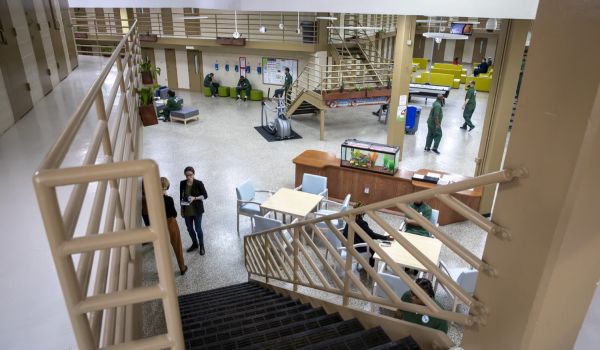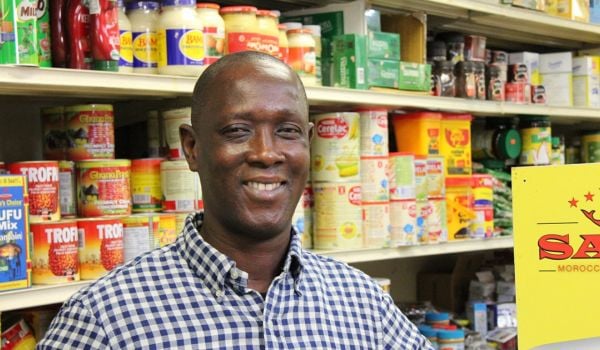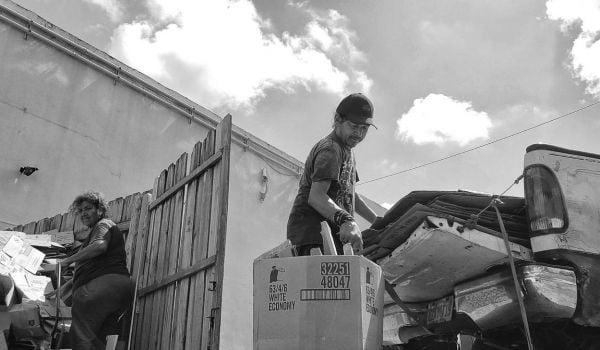Gavin Newsom wants to “completely reimagine what prison means.” That’s what the California governor told The Los Angeles Times in mid-March when he announced a sweeping plan to transform San Quentin State Prison, the state’s oldest and most notorious maximum-security prison, into an institution that’s focused on “education, rehabilitation, and breaking the cycles of crime” by 2025.
According to the governor’s office, the “California Model” will borrow best practices from Scandinavian countries like Norway—which has one of the lowest recidivism rates in the world—to help formerly incarcerated people “return to their communities as productive members of society.” The office also cited research showing that every $1 spent on rehabilitation saves more than $4 on costs of re-incarceration. His 2023-24 budget proposal earmarks $20 million to get it started.
“We have to be in the homecoming business,” Newsom told the press.
Left out of Newsom’s rehabilitation plan, however, is a certain subset of the incarcerated population: non-U.S. citizens who served time in the criminal legal system, only to be transferred into immigration detention and ultimately deported to their native countries.
Immigrant advocates call it “double punishment” that amounts to permanent, sanctioned family separation — extinguishing the hope of them ever coming home. In California, which has the largest immigrant population in the country, the exclusion of non-citizens from the governor’s prison reform efforts is a conspicuous oversight.
Not only is this prison-to-deportation pipeline devastating communities across the state and the country, but there are significant financial costs – for immigrants and all taxpayers.
‘From cage to cage’
Many prison abolition advocates are skeptical of the California Department of Corrections and Rehabilitation’s (CDCR) ability to reform itself.
“The last thing California needs is a new philosophy of incarceration led by [the CDCR], who have proven themselves poor stewards of the public trust,” Brian Kaneda, deputy director for Californians United for a Responsible Budget, told Cal Matters.
According to Assemblymember Mia Bontaonly, about 3% of the CDCR’s $14.5 billion budget goes toward rehabilitation.
CDCR also collaborates with U.S. Immigration and Customs Enforcement (ICE) on transfers to immigration detention once individuals have served their time in prison.
“They’re directly sent from cage to cage,” says Elijah Chhum, director of the New Light program at the Oakland-based Center for Empowering Refugees, a community-based mental health and holistic wellness organization with many clients among this population.
Once someone is in ICE custody, the real expenses begin to accrue.
ICE does not own or operate most facilities in its vast network of jails to house detained individuals before deportation; instead, it awards detention contracts to private prison companies like GEO Group, currently valued at $2.38 billion. According to Detention Watch, the average cost for adult detention in FY21 was $125.06 per day.
ICE’s current FY 2023 budget is $8.5 billion, with $1.4 billion designated for 25,000 detention beds. Taxpayers will foot the bill even if the beds are empty, but it is nonetheless a priority for ICE to meet its quotas. Some facilities have guaranteed minimum occupancy, meaning ICE is required to keep a minimum quota of detained persons, which the agency has defended as helping them negotiate a lower rate per detainee.
What’s more, the Supreme Court ruled last year that those detained in immigration detention can be held indefinitely, guaranteeing a reliable revenue stream for ICE and its contractors.
“We’re constantly seeing ICE detention systems as a profit-making machine for private companies like GEO Group,” says So Young Lee, an immigrant rights attorney at the Advancing Justice-Asian Law Caucus. “And they’re profiting off the lives of communities of color.”
ICE has the ability to release individuals home to their family and community, she says, but rarely use it. Lee described one case in which ICE had agreed to place their client on an ankle monitor and return her home when there were no beds available. But, instead of releasing her, “ICE found a bed hundreds of miles away and actually expended resources to fly our client out to fill that bed.”
ICE maintains that it can move detained individuals for virtually any reason, and oftentimes, these relocations are immediate—and secret.
“ICE loves to keep families apart, so they move community members from different detention centers,” says Chhum. “We’re like, ‘Okay, where are they today?’ Families are trying to drive to them as much as they can. Are they in Yuba? In Bakersfield? Or are they in Arizona now or did they just get to Texas?”
Chhum has heard from family members about the logistical costs of visiting their loved ones (once they’ve actually located them), such as driving and paying for accommodations. That takes resources and capacity that few families can afford. Even then, says Chhum, families have a narrow window to visit their loved one before ICE relocates them again—to another ICE facility, a consulate to get their travel documents or to initiate their deportation.
Transport is another inflated taxpayer expense. ICE has a suite of contracts with air charter flights, commercial flights, and ground transportation to shuttle detained individuals from facility to facility. The FY 2023 budget also earmarked $421 million for such logistics.
In the well-publicized case of Phoeun You, 49, who was deported last summer after a hard-fought campaign to return him to his community after 26 years in prison. In 2021, he was granted early release after a parole board deemed him “no longer a threat to society.” But he was directly transferred into ICE custody for five months before being deported without notice to Cambodia, a country he hadn’t seen since he was a 4-year-old fleeing the Khmer Rouge genocide with his family. “I wonder how much money the U.S. spent in housing me in ICE for the five months and change,” he says from his new home in Phnom Penh. “I wonder how much it cost them to fly me out to Virginia (from California) and back when I had my interview with the Cambodian embassy, and I wonder how much it cost for them to get me here.”
There were also several ICE agents accompanying You as they delivered him to Cambodian authorities, he notes. “They gotta get paid, you know. Was it really money well spent?”
A ripple effect in the community
As Prism has reported, Southeast Asians are three-to-four times more likely to face deportation for past convictions compared to other immigrant communities. Currently, roughly 80% of the estimated 15,000 Southeast Asian refugees facing deportation were convicted of a crime, have completed their sentences, and have final orders of removal.
In addition to direct transfers from CDCR and state custody to ICE, the Advancing Justice-Asian Law Caucus also serves clients with old removal orders, says Lee, often from decades ago. These are formerly-incarcerated individuals who served their criminal sentences and reentered their communities, reintegrated, and rebuilt their lives—exactly, as Newsom expressed, as “productive members of society”—only to be suddenly detained and deported.
“They get their lives back together and start a family,” says Lee. “When ICE picks them up, it’s extremely disruptive, not just in terms of family separation and how it impacts the kids, but also for [their partner] who now has to be a single parent.”
Lee says many of their clients were also primary caregivers for siblings, aging parents, and other relatives. “And when that gets taken away, it’s not just taking away the emotional the physical support but also the financial support.”
You’s family told Prism that his homecoming would have taken the strain off his older sister, who had cared for their aging parents while working full-time.
The true cost of their absence to the community, Lee says, is incalculable. “No one can put a dollar amount on what it costs to separate a family and deport someone who is very loved.”
The cost of a new beginning
The U.S. Ambassador to Cambodia, W. Patrick Murphy, told reporters that the U.S. allocates some funding to resettlement assistance. But how effectively those funds help returnees succeed in their new environment remains to be seen.
Upon arriving in Cambodia, You likened the transitional housing he entered to a carceral setting: his room, he says, as having a metal bed and barred windows. “I couldn’t shift the fact that I was free when I was in a living condition that triggered me into prison again.”
Chhum’s New Light program, which provides mental health outreach and services for impacted families, is trying to extend its offerings to more robust telehealth mental health and wellness services for community members like You who’ve already been deported. But the perennial issue is funding: Few existing grants allow the program to holistically meet the needs of this population. “We have to be adaptable and flexible with our community,” says Chhum. “Within three to five years, our entire community can change; needs will differ. There just aren’t a lot of programs and grants specifically designed for [that].”
Instead of psychosocial support on the ground upon reentry, returnees like You are left to rebuild their lives on their own—in an entirely unrecognizable setting and a language they may not know anymore.
“It was really brutal in the beginning,” says You. “What am I stepping into next, and what is that going to look like? How am I going to feed and clothe myself freshly out of prison after 26 years? It hurts to look around and feel like you don’t know whom to ask for help.”
The first priority for formerly-incarcerated individuals upon their reentry is securing financial stability, which is a leviathan task when they are unfamiliar with the local language, culture, and social norms.
During his time at San Quentin, You worked for the award-winning San Quentin News and had envisioned a career in journalism upon release, but that’s no longer available to him here: Cambodia’s hostility toward a free press is well documented. “I’m in a country where I don’t know the politics,” says You. “I could report on the wrong thing and be thrown in jail. My safety was really brought to the forefront because no way, no how would I ever want to go back to jail. I really want to be safe.”
Nor is his restorative justice experience a viable profession here. While incarcerated, You became a certified counselor through Bay Area Women Against Rape and co-founded ROOTS (Restoring Our Original True Selves), an ethnic studies program for incarcerated Asian and Pacific Islanders, many of whom became his mentees. Upon his release, You had two job offers awaiting him outside prison, Prism previously reported: one by restorative justice organization Stronghold and one by Rafiki Coalition, which provides culturally affirming health and wellness services. For now, he says, You must put this work on the backburner.
The great irony of Newsom’s announcement, of course, is that his plans could use You’s talent.
Because You was convicted of an aggravated felony, he was immediately sent through to deportation proceedings upon his release. Now that he’s been deported, he faces a lifetime ban from returning to the U.S. and ever seeing his parents, his family, and his community again.
Only the exceedingly rare option of a gubernatorial pardon—from Newsom himself—could bring him home. Until then, You must spend carefully, because he doesn’t know when the next job opportunity will arise.

Frances Nguyen is a freelance writer, editor of the Women Under Siege section (which reports on gender-based and sexualized violence in conflict and other settings) at the Women's Media Center, and a member of the editorial team for Interruptr, an online space for women experts to disrupt discourse in traditionally male-dominated focus areas. She is currently working on a creative nonfiction portfolio on race, identity, and the American Dream.







_600_350_80_s_c1.jpg)








